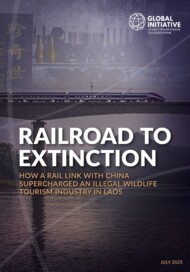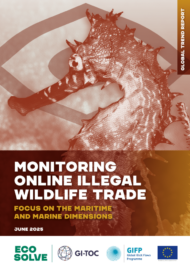Posted on 22 Jul 2025
The China–Laos Railway has enabled a dramatic expansion of illegal wildlife trade (IWT) in Laos, transforming the country into a critical node in transnational trafficking networks. According to this report, result of a joint investigation with Mongabay, the railway’s launch catalysed a tourism boom that is being exploited to funnel Chinese visitors to shops openly selling illegal wildlife products—including rhino horn, elephant ivory, bear products, tiger parts and pangolin products.
These products are sold in at least 18 large-scale venues across Laos that operate under the cover of cultural centres, museums, jewelry stores, and coffee shops. Despite appearing legitimate, many of these venues are embedded in organized tour circuits designed specifically for Chinese tourists. The tours use coded language and marketing tactics to disguise illegal wildlife product sales as “cultural shopping” experiences.
Since the cross-border train service opened in April 2023, the number of Chinese tourists travelling to Laos surged from 45,000 in 2022 to over 1 million in 2024, with projections of 1.3 million in 2025. The report highlights how the railway, part of China’s Belt and Road Initiative, has dramatically increased accessibility to previously hard-to-reach areas, enabling the growth of this illicit economy linked to tourism.
Our analysts found that tour operators pre-register Chinese tourists using their passports and take them to venues where IWT products are sold. Receipts are issued under innocuous names such as “Kinliao Coffee”, “Laos Shopping Stop” and some venues feature armed guards, government authority logos, and portraits of Laotian and Chinese officials, creating the appearance of state endorsement.
Despite Laos being a party to CITES since 2004 and receiving over US$81 million in donor funding for counter-IWT efforts, enforcement remains minimal. Wildlife products prohibited under Laotian, Chinese and international law are sold almost openly in the capital and major tourist areas, raising serious concerns about governance and corruption.
The study’s revenue model suggests that even conservative levels of tourist spending at these venues could generate millions of dollars in illicit revenue each high season. If scaled to the 1 million+ Chinese tourists who visited Laos in 2024, the illegal wildlife trade could be worth over US$400 million, rivaling the country’s official tourism earnings.
The report concludes that urgent action is needed. While enforcement and top-level pressures are clearly needed within Laos, China also has clear legal grounds to investigate and prosecute its citizens and tour companies involved in overseas IWT. Meanwhile, donor countries must reassess how conservation funding is deployed, given the lack of progress despite substantial investment.
What is unfolding in Laos is not hidden. It is packaged, promoted and sold under the cover of cultural tourism, aided by infrastructure designed to promote development. Without accountability and international pressure, Laos risks becoming a model for IWT impunity in the region.




